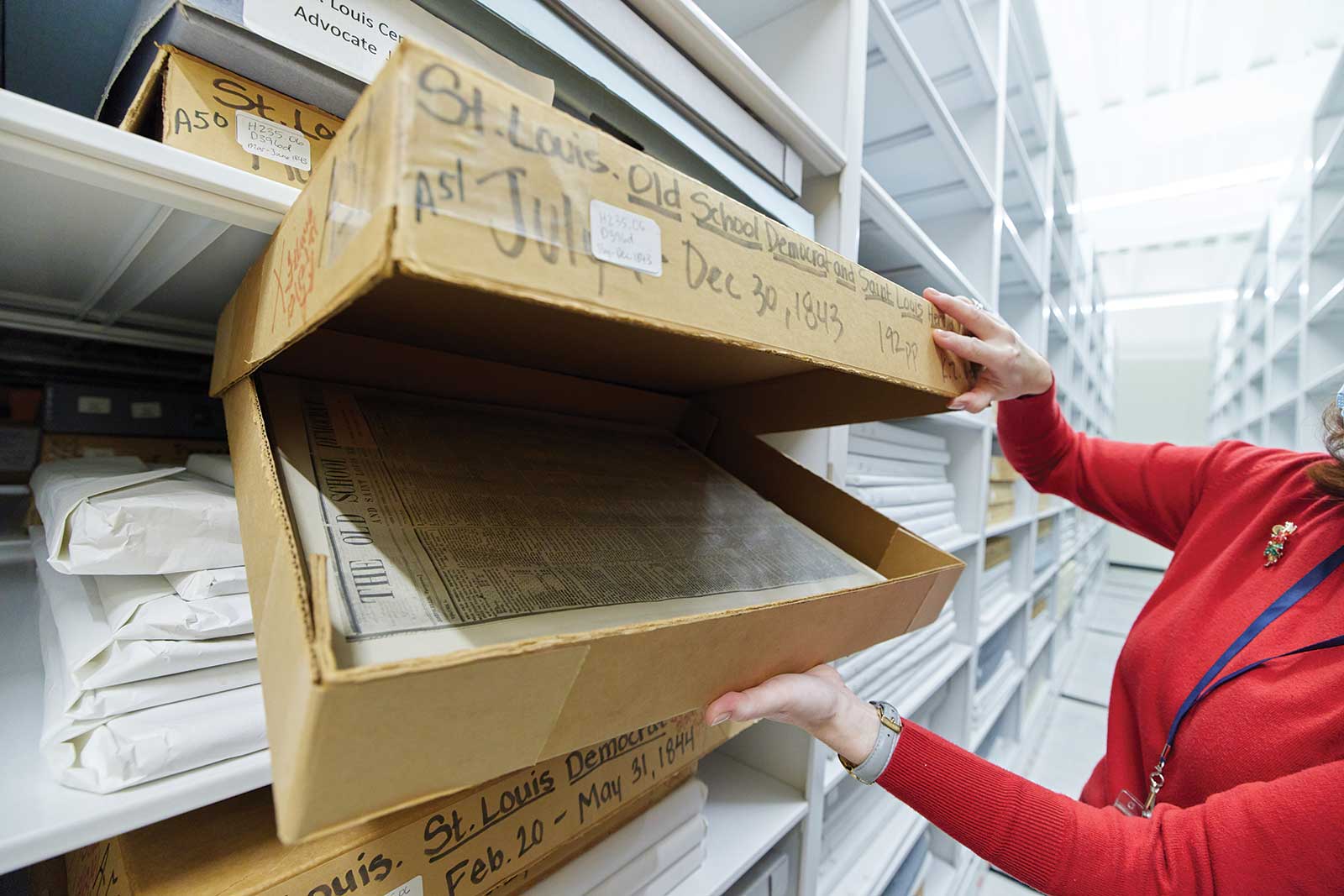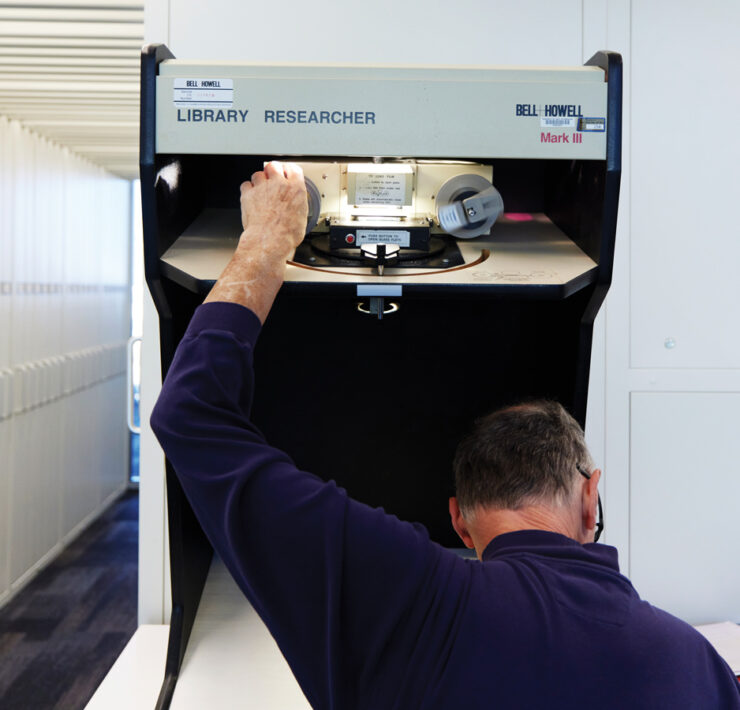Curators of the Lost Art and Artifacts
- Photos by Keith Borgmeyer at the State Historical Society of Missouri's Center for Missouri Studies

Columbia’s museums hold a treasure trove of art, artifacts, and history unparalleled by other communities of its size. Even better, they’re absolutely free to explore.
To say that museums preserve history is accurate, although the statement often invokes a smell of musty attics and molding books. Preservation is undoubtedly a key function shared by Columbia museums, but their collective mission is to entertain, educate, and inspire.
Every year, thousands of people visit the Boone County History & Culture Center, Masonic Home of Missouri, MU Museum of Anthropology, MU Museum of Art & Archaeology, and State Historical Society of Missouri. Although the pandemic has reduced crowds, it also prompted the museums to digitize an increasing number of their collections so people can view them online. Even better, this makes available a significant number of archived items the museums don’t have space to exhibit at all times.
Whether you explore in person or virtually, explore away. You might be surprised at the treasures you find.
Boone County History & Culture Center
MU Museum of Art & Archaeology
State Historical Society of Missouri
Boone County History & Culture Center
“The Smithsonian’s American History Museum believes we might have the largest aggregate photography collection of any one community in the nation,” says Chris Campbell, executive director of the Boone County Historical Society, founded in 1924.
That collection comprises half a million photo negatives from nine Columbia photography studios between 1886 and 1970. A team of mostly volunteers is digitizing the photo collection and early 19th century Boone County Court records so anyone can view them on the society’s website.
John W. “Blind” Boone’s custom 1893 grand piano is housed at the museum, and a 1927 Model-T Ford is arriving soon. Although preserving the past of Columbia and Boone County is important, so is collecting history in the making. The center exhibits the work of contemporary regional artists and journaling of residents about life during the COVID-19 pandemic.
The Boone County Historical Society hosts events featuring local authors, the Blind Boone Piano Concert Series, and special exhibits. It rents some of its venues out, including the Maplewood House, Montminy Gallery, the Nifong Park veranda, and the center’s gazebo.
“We preserve the triumphs, fears, successes, and challenges that Boone Countians have faced for generations, from settling in an unknown territory to the impact of COVID-19,” Chris says.
Chris says they’re always looking for more volunteers. As one of the current volunteers says: “We think it is important to figure out what would matter most if we lost it. History and the arts are among the things that matter.”
www.boonehistory.org | 3801 Ponderosa St. | (573) 443-8936
Masonic Home of Missouri
You may not crack The Da Vinci Code by visiting the Masonic Home of Missouri, but you will learn a lot about the history of Freemasons in Missouri. There have been a few Missouri Masons of note, such as President Harry Truman, Merriweather Lewis and William Clark of expedition fame, politician Thomas Hart Benton, and Samuel L. Clemens, also known as Mark Twain. Author Laura Ingalls Wilder was a member of the Order of the Eastern Star, another group associated with the Masons.
The Masonic Home’s collections include everything from late 19th century art glass windows to a poster from the Hollywood production of Rudyard Kipling’s “The Man Who Would Be King” featuring an illustration of Sean Connery wearing a necklace bearing a Masonic symbol. There’s also a gavel Clemens made from a cedar tree outside the walls of Jerusalem and donated to his St. Louis lodge.
Most recently, the Masonic Home opened a temporary exhibit featuring the stories of Masons who built Columbia and MU. Familiar local surnames throughout the exhibit, including Garth, Lenoir, Todd, Lang, Rollins, and Gentry, connect Freemasonry with Columbia.
“The Masonic Museum often takes new visitors by surprise,” says Barbara Ramsey, executive director. “The museum is designed to tell stories in small-bite pieces and go through it quickly, but it can also take an hour or more for those wanting to read all the details along the way. It is sometimes referred to as a ‘best-kept secret,’ but we hope to change that.”
www.museum.mohome.org | 6033 Masonic Dr., Ste. A | (573) 814-4663
MU Museum of Anthropology
You might think the MU Museum of Anthropology is an odd place to house Ghost Dancing, the van that William Least Heat-Moon drove around the country in 1978. He logged 13,000 miles and talked to hundreds of people about their lives before writing his famous memoir, “Blue Highways.” If you ever wondered what happened to the van, you now know it came back to roost in Columbia.
If you’re too young to remember “Blue Highways” but loved “The Hunger Games,” the museum is also home to the Grayson Archery Collection. It’s the largest archery collection in the world, featuring artifacts from six continents spanning more than 800 years. And if you’re just interested in the weird and wonderful, there’s the world’s oldest open-toed sandal, made from the native prairie plant rattlesnake master more than 8,100 years ago.
“We are the only anthropology museum in Missouri and one of only a few in the Midwest,” says Candace Sall, director. “Our collections are used in research to learn more about the past and also to make improvements for the future.”
That doesn’t mean the museum is only used by academics. Although it is closed for now while it constructs space in Ellis Library on the MU campus, which will be its new home, many of the museum’s artifacts are available for online viewing to anyone. The museum began collecting artifacts in 1885. Collections from North America date from 9,000 BC to the present; other artifacts are more than two million years old.
www.anthromuseum.missouri.edu | Moving to Ellis Library, MU campus | (573) 882-3573
MU Museum of Art & Archaeology
Imagine a single museum that combines antiquities sought by Indiana Jones with original works by Andy Warhol and you can imagine the MU Museum of Art & Archaeology. Although it’s currently moving from Mizzou North to Ellis Library, many of its artifacts are accessible for online viewing.
“We are an encyclopedic collection from ancient to modern and contemporary art,” says Bruce Cox, interim director. “We show the progression of art historically from the ancient world to the present day.”
Collections hail from the ancient Mediterranean world and ancient Americas, the Byzantine Empire, Africa, and Asia. You can lose more time scrolling through the online photos of paintings from the 1400s through the 20th century than you do scrolling through your Facebook feed.
The quirky 1996 multi-media “Anten-nalope,” like many of the museum’s artifacts, is probably worth a visit all on its own. But don’t miss some of the more unique pieces, including “Nkisi’ Nkondi – Power Figure,” an early 20th century sculpture from the Kongo people. It’s a frightening wooden figurine of a man covered with nails, believed to summon the supernatural into the world.
Exhibitions, once in the museum, are available online with a click, including “Fifteen Minutes of Warhol,” Pre-Columbian Pottery, or “Black Women in Art and the Stories They Tell.” There truly is something for everyone.
“Spend time with the art and let it speak to you,” Bruce says. “Art settles the spirit and inspires the mind.”
That’s something we could all use a little of right now.
www.maa.missouri.edu | Moving to Ellis Library, MU campus | (573) 882-3591
State Historical Society of Missouri
Joan Stack, art curator for the State Historical Society of Missouri, characterizes the interrelationship between art and history as “complex.” The society aims to engage people through its exhibitions and programs to help them understand that complex relationship using the thousands of paintings, drawings, sculptures, and fine art prints that comprise its collection.
Original paintings like George Caleb Bingham’s “General Order No. 11,” depicting a Civil War scene, and Thomas Hart Benton’s “Year of Peril,” a graphic series of paintings created during World War II, draw visitors from around the country. According to Joan, visitors are also delighted by the portrait of the Truman family painted by Greta Kempton.
Although most people associate Benton with art, the society also has sheet music written in his hand for the harmonica. There’s a brooch containing a tiny daguerreotype of Bingham. Those aren’t historical artifacts you can see just anywhere. The society’s collections even include a pipe owned by Samuel Clemens, who was known for his voracious appetite for smoking pipes and cigars.
Currently on display is a bronze bust of Mizzou coaching legend Norm Stewart on top of a bronze basketball. Joan notes that Sabra Tull Meyer’s use of a basketball as a base for the sculpture “has a wonderfully whimsical quality.” This isn’t just another art gallery.
“We have a much stronger historical focus than many art galleries,” Joan says. “We also specialize in Missouri artists and artwork related to Missouri and American history.”
www.shsmo.org | 605 Elm St. | (800) 747-6366








